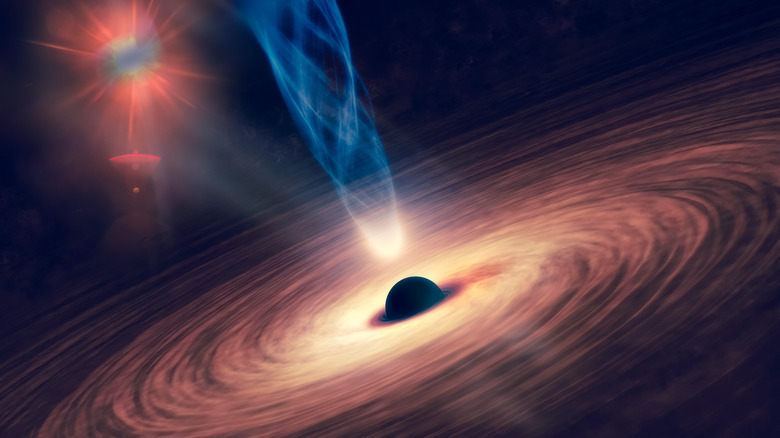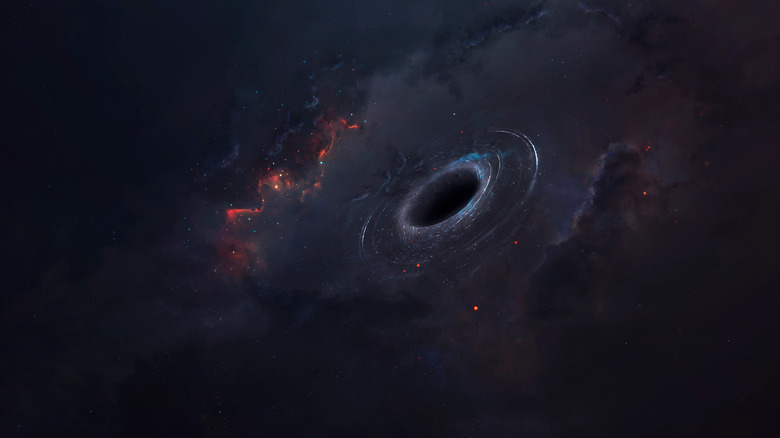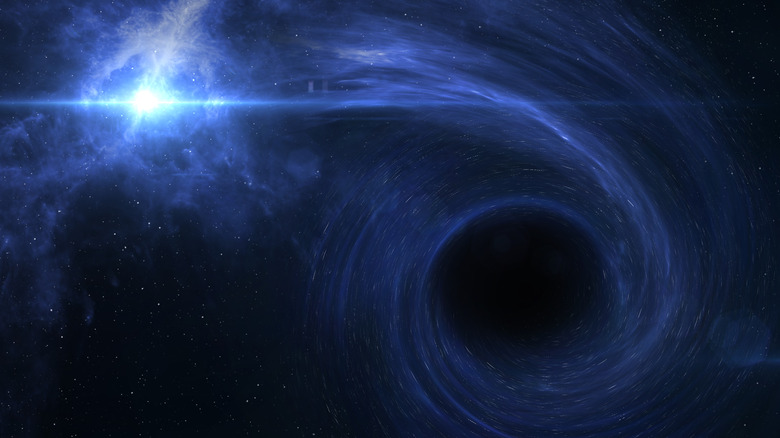The White Hole Space Theory Explained
Black holes definitely get a lot of attention for being the big, bad marauders of astrophysics. They seem downright science fictional: Incredibly dense points in space with gravity so strong that not even the fastest thing in the universe — light — can escape? Formed from the collapsed remains of a star that went supernova and scattered its heavy metals (horns up) around the cosmos? Those same scattered metals now composing some critical components of, say, your smartphone? Yes, your phone is made from stars.
Only the densest of stars will become black holes. In the struggle of radiation (pushing out) versus gravity (pulling in), particularly dense stars fuse not only hydrogen and helium, like our sun, but other elements: carbon and neon to oxygen and silicon, and finally iron. Iron, however, radiates nothing. And so, gravity eventually wins out, sucks everything in, and boom: you've got an infinitely dense point called a "singularity" surrounded by an event horizon, a swirling exterior we were just able to "see" in 2019 (per National Geographic). Black holes' gravity is so strong that it warps spacetime itself and send out shockwave-like ripples called "gravitational waves."
So what in the world is a "white hole"? Well, they're completely theoretical opposite versions of black holes: They emit everything, but absorb nothing. Right now, they exist only on paper and have never been measured. If they exist, they could solve some of physics' more annoying problems, and even account for the mysterious, undefined substance, "dark matter."
Black hole opposites: nothing in, everything out
When something enters a black hole, it can never escape. Particles, energy, etc. — information, essentially — is trapped forever. At least, everything except Hawking radiation, as Science Alert says: one virtual particle at a time lost from its quantum pair. Eventually, over hundreds of billion of years, black holes will lose all their information, and leave in their place ... what? This relates to white holes, so remember the question.
A white hole is the "opposite," in that it emits all of its information and energy, as Space says. And opposite to a black hole, nothing can ever enter it. But there's the problem: If white holes emit everything they have/are, but nothing can enter ... how do they contain anything to begin with? Well, like any celestial body, a white hole used to be something different.
One of the biggest takeaways from Einstein's 1915 Theory of General Relativity, which we're still trying to wrap our heads around over 100 years later, is that space isn't some cardboard cutout with objects like stars and planets slapped on top it. The objects in space "change space" — change their backdrop — because spacetime is a flexible, fabric-like material that bends, warps, dents, what-have-you. They interact with and alter each other, and so spacetime itself evolves — so do its objects. Hence, stars become phones. Information can change form, dissipate, coalesce, but ultimately never be destroyed.
So white holes? They might have once been black holes.
One possible fate of a black hole
It makes sense, doesn't it? If an energy-hugging black hole was dense enough, could it somehow "flip" and start jettisoning its information out? Mathematically, the answer is "yes." Play with the values a bit, and black holes basically "invert," as Science Alert tells us. In fact, this could have already happened — not with supermassive black holes like those in the center of our galaxy, but with smaller black holes, the kind that already lived as stars and went supernova in the earlier stages of the universe, as Seeker explains. Funny enough, these invisible white holes that emit wavelengths shorter than any light (therefore invisible) could be the mysterious substance called "dark matter" acting as a gluey, attractive force giving galaxies the mass they need to stay intact. Dark matter accounts for 27% of all matter in the universe, per CERN.
In what is "the craziest time scale I've seen in physics," as Hal Haggard says on Space, the same thing could happen with supermassive black holes. Wait long enough — like trillions of years — and the universe could be populated by a mixture of black holes dying via the loss of Hawking radiation and, sometimes, flipped black-holes-turned-white. White holes can't exist for long, though, and are generally no wider than a human hair. For a brief dying spark, they would release everything they once were, like a brighter, alternative end to the life of a long-dead star.


